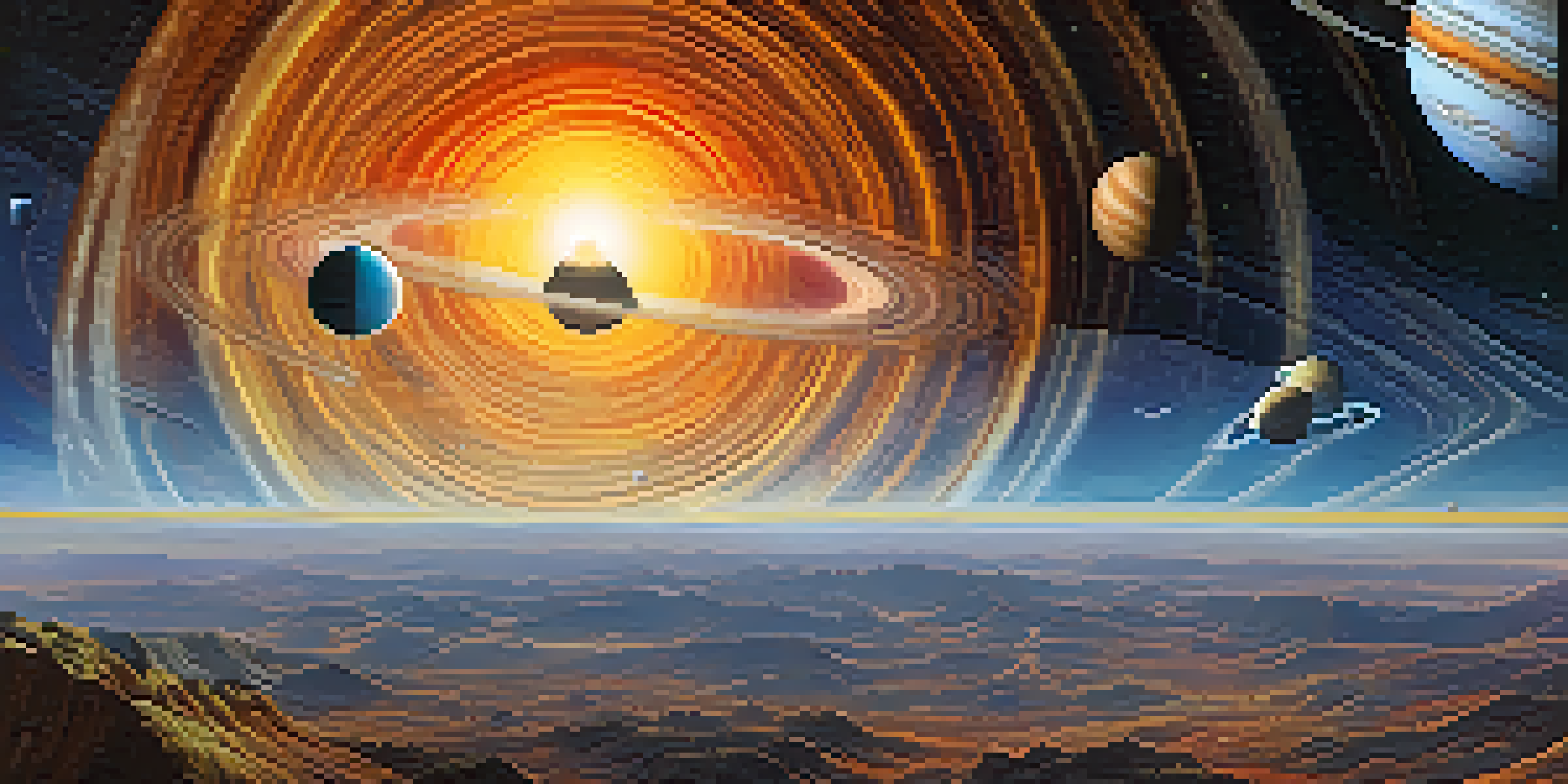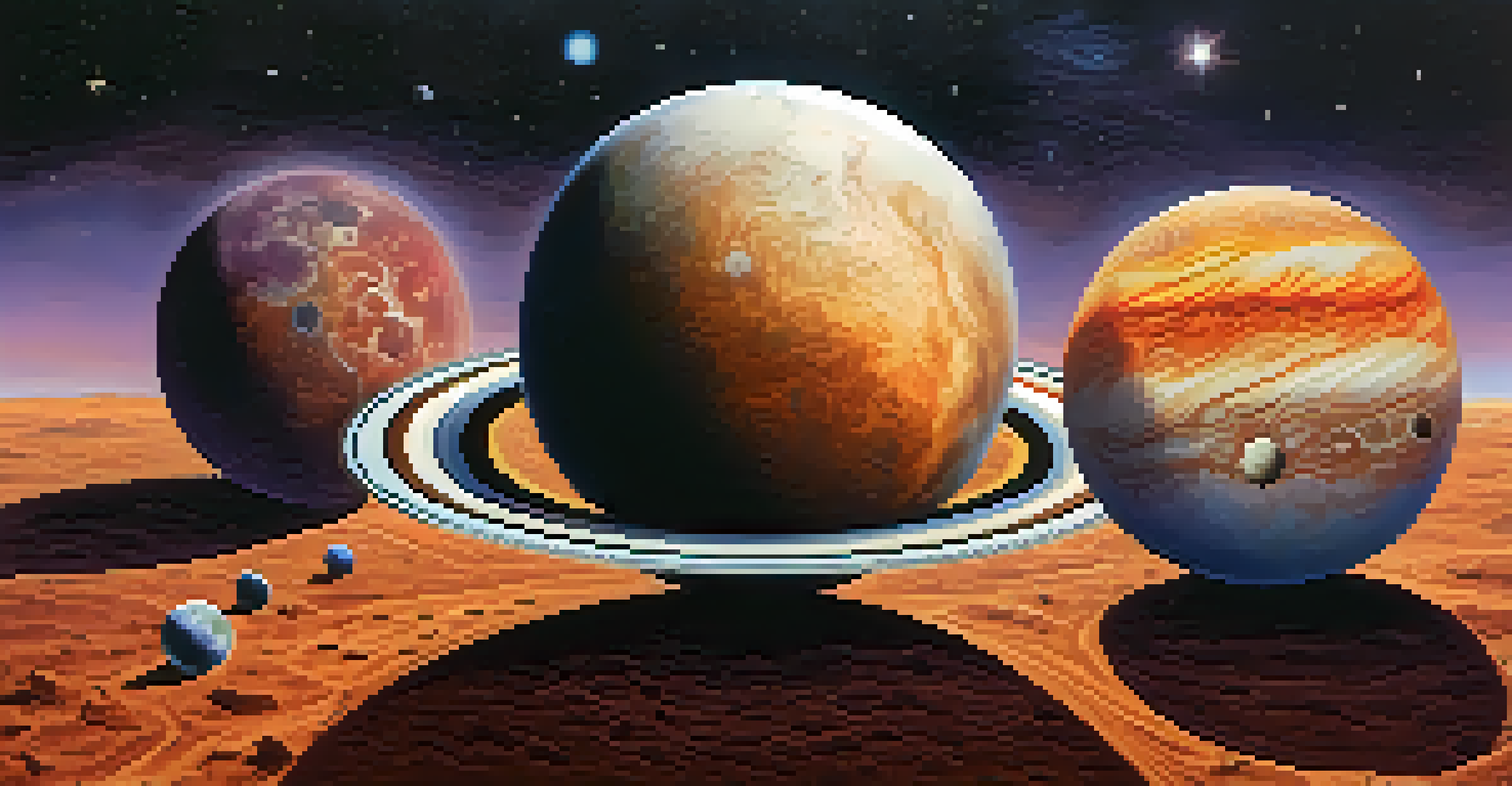The Solar System: An Overview of Its Composition and Planets

What Makes Up Our Solar System?
The solar system is a vast and fascinating region of space that includes the Sun, planets, moons, asteroids, comets, and much more. At its heart lies the Sun, a massive star that provides the necessary light and heat for life on Earth. Surrounding this central star, we find eight major planets, each with its own unique characteristics and compositions.
The cosmos is within us. We are made of star-stuff. We are a way for the universe to know itself.
In addition to planets, the solar system is filled with smaller celestial bodies, like dwarf planets such as Pluto and countless asteroids and comets that orbit the Sun. The gravitational pull of the Sun keeps these objects in a delicate balance, creating a dynamic environment that is ever-changing. This rich tapestry of components is what makes our solar system so intriguing to scientists and enthusiasts alike.
Understanding the composition of the solar system helps us grasp the forces and processes that govern it. From the fiery depths of the Sun to the icy realms of the outer planets, each element plays a crucial role in the overall structure and function of this celestial neighborhood.
The Inner Planets: Rocky and Resilient
The four inner planets—Mercury, Venus, Earth, and Mars—are known as terrestrial planets due to their rocky surfaces. These planets are relatively small and are characterized by their solid ground, which sets them apart from the gas giants that lie beyond. Mercury, the closest planet to the Sun, experiences extreme temperatures, while Venus is often called Earth's twin due to its similar size and composition.

Earth, the only planet known to support life, boasts a unique atmosphere and abundant water, which makes it a vibrant oasis in the solar system. Mars, with its dusty red surface and polar ice caps, has fascinated scientists for years as they search for signs of past or present life. Each of these inner planets offers a glimpse into the variety of environments that can exist within our solar system.
Solar System's Diverse Components
The solar system comprises the Sun, eight planets, dwarf planets, asteroids, and comets, all interacting in a dynamic environment.
The study of these rocky worlds not only provides insights into the formation of the solar system but also enhances our understanding of Earth's own geology and climate. By examining the similarities and differences among these planets, we gain valuable knowledge about the processes that shape planetary bodies.
The Outer Planets: Gas Giants of Wonder
Beyond the inner planets lie the outer planets: Jupiter, Saturn, Uranus, and Neptune, which are categorized as gas giants. These colossal planets are predominantly composed of hydrogen and helium, giving them their massive sizes and distinctive atmospheres. Jupiter, the largest planet in our solar system, is famous for its Great Red Spot, a giant storm that has been raging for centuries.
Somewhere, something incredible is waiting to be known.
Saturn, renowned for its stunning ring system, captivates astronomers and stargazers alike. These rings are made up of ice particles, rocky debris, and dust, creating a mesmerizing spectacle that showcases the planet's beauty. Uranus and Neptune, often referred to as ice giants, contain higher amounts of water, ammonia, and methane, contributing to their unique blue and green hues.
The outer planets are not just beautiful; they also play critical roles in the solar system's dynamics. Their immense gravitational forces influence the orbits of other celestial bodies, while their myriad moons and rings provide additional layers of complexity and mystery for scientists to explore.
Dwarf Planets: A Category of Their Own
Dwarf planets, like Pluto, Eris, and Ceres, represent a unique category within our solar system. Although they share some characteristics with the larger planets, they do not clear their orbital paths, which is a key reason they are classified separately. This distinction has sparked much debate and curiosity among astronomers and the public alike.
Pluto, once considered the ninth planet, has become a symbol of this category, leading to discussions about what defines a planet. Its complex atmosphere and diverse terrain, which includes mountains and ice plains, continue to intrigue scientists. Eris, located in the scattered disc region, is even more massive than Pluto, prompting further questions about the nature of these distant worlds.
Inner vs. Outer Planets
The inner planets are rocky and terrestrial, while the outer planets are gas giants with unique characteristics that influence the solar system.
Studying dwarf planets sheds light on the early solar system and the processes that led to the formation of planets. As we explore these smaller celestial bodies, we uncover the rich history of our solar system and the diverse environments that exist beyond the familiar planets.
Asteroids: The Building Blocks of Planets
Asteroids are rocky remnants from the solar system's formation and can be found mainly in the asteroid belt between Mars and Jupiter. These small, irregularly shaped bodies vary in size, with some being as small as a pebble and others as large as a mountain. Understanding asteroids is crucial, as they offer clues to the early solar system and the materials that formed the planets.
Some asteroids even have their own moons, known as binary asteroids, which adds complexity to their study. While most asteroids reside safely within the belt, others, called near-Earth asteroids, have orbits that bring them close to our planet. Tracking these near-Earth asteroids is vital for understanding potential impact threats and for future exploration.
Asteroids not only provide insights into the past but also hold potential resources for the future. Scientists are researching ways to mine asteroids for materials like metals and water, which could support human missions beyond Earth. This exploration of asteroids opens up new possibilities for space travel and resource utilization.
Comets: Cosmic Snowballs of the Solar System
Comets are often described as cosmic snowballs, composed of ice, dust, and rocky material. They originate from the colder regions of the solar system, particularly from the Kuiper Belt and the Oort Cloud. When a comet approaches the Sun, the heat causes the ices to vaporize, creating a glowing coma and sometimes a beautiful tail that stretches for millions of kilometers.
One of the most famous comets, Halley's Comet, has been observed for centuries and is expected to return in 2061. The sight of a comet streaking across the night sky has captivated humanity, sparking awe and wonder throughout history. These celestial visitors not only provide stunning visuals but also valuable data about the solar system's origins.
Importance of Comets and Asteroids
Comets and asteroids serve as vital clues to the solar system's formation and present potential resources for future exploration.
Studying comets helps scientists understand the building blocks of planets and the conditions present during the early solar system's formation. They are considered time capsules, preserving ancient materials that can reveal secrets about the solar system's history and the potential for life beyond Earth.
The Sun: The Heart of Our Solar System
At the center of our solar system lies the Sun, a massive ball of hot plasma that provides energy to all the planets and celestial bodies. Comprising about 99.86% of the solar system's total mass, the Sun's gravitational pull keeps everything in orbit, from the smallest asteroid to the largest planet. Its immense heat and light are essential for life on Earth, making it a vital component of our cosmic neighborhood.
The Sun undergoes constant nuclear fusion, converting hydrogen into helium and releasing tremendous energy in the process. This energy travels through space and reaches Earth, providing warmth and sustaining life. Solar activity, such as sunspots and solar flares, can impact space weather and even affect communication systems on our planet.

Understanding the Sun is crucial for comprehending the dynamics of the entire solar system. Ongoing research and missions, such as the Parker Solar Probe, aim to unveil the mysteries of our star, shedding light on its behavior and its influence on the planets, including Earth. The Sun's role as the heart of the solar system cannot be overstated; it is the source of life and energy that drives the cosmos.